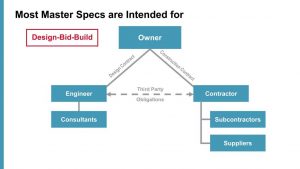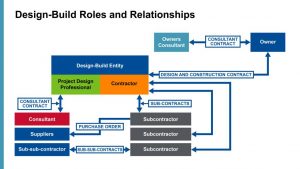by Kevin O’Beirne, PE, FCSI, CCS, CCCA

Specifications originally intended for design-bid-build (DBB) projects require significant revisions to be suitable for design-build or integrated project delivery (IPD).
A substantial challenge faced by professionals preparing construction specifications for design-build projects is most master specifications were developed for traditional DBB or its ‘close relation,’ design-negotiate-build (DNB). Often, DBB specifications can be adapted with reasonable effort and cost for use on construction manager as advisor (CMa) and construction manager-at-risk (CMAR) projects. Greater challenges arise when adapting DBB source documents for design-build.
DBB and its ‘relatives’ are longstanding methods of project delivery with clearly defined roles and responsibilities, and, therefore, drafting construction specifications for such projects is reasonably straightforward.

In DBB, DNB, CMa, and CMAR, the owner directly hires a third-party design professional to prepare the construction documents—over which the owner has full control throughout the design stage—prior to the contractor preparing its final pricing and constructing the facility. In each of these delivery methods, the design professional typically prepares prescriptive, detailed specifications and drawings. The contractor is required to build the project in complete compliance with the drawings, specifications, and other contract documents (Figure 1).
Thus, whether it is the master specifications of an architecture or engineering firm or project owner, SpecsIntact (an automated master specifications system used by several government agencies), or commercial master guide specifications, chances are the available source documents were written for DBB projects. There are several factors to consider when adapting DBB specifications for use on a design-build project.
Design-build contractual relationships

In design-build, the owner typically enters into a single prime contract with an entity called the design-builder that is responsible for both designing and building the project. The design-builder may be a single organization with in-house design and construction expertise and licensure or, more commonly, it is either a contractor or design professional teaming with one or more partners via subcontracts (Figure 2).
An optional entity in design-build is an ‘owner’s consultant’ (not the project’s design professional) that may be retained to help the owner in selecting the design-builder and, perhaps, in fulfilling its duties under the owner–design-builder prime contract.
According to a June 2018 report titled “Design-Build Utilization Combined Market Study,” prepared for the Design-Build Institute of America (DBIA), up to 44 percent of the United States’ non-residential construction market in 2018-2021 is predicted to employ design-build project delivery, especially in manufacturing, highway/streets, and education. The proportion of spending using design-build may vary with the type of construction and the status of enabling legislation in each jurisdiction but, regardless, design-build will represent a substantial portion of the modern design and construction market.




